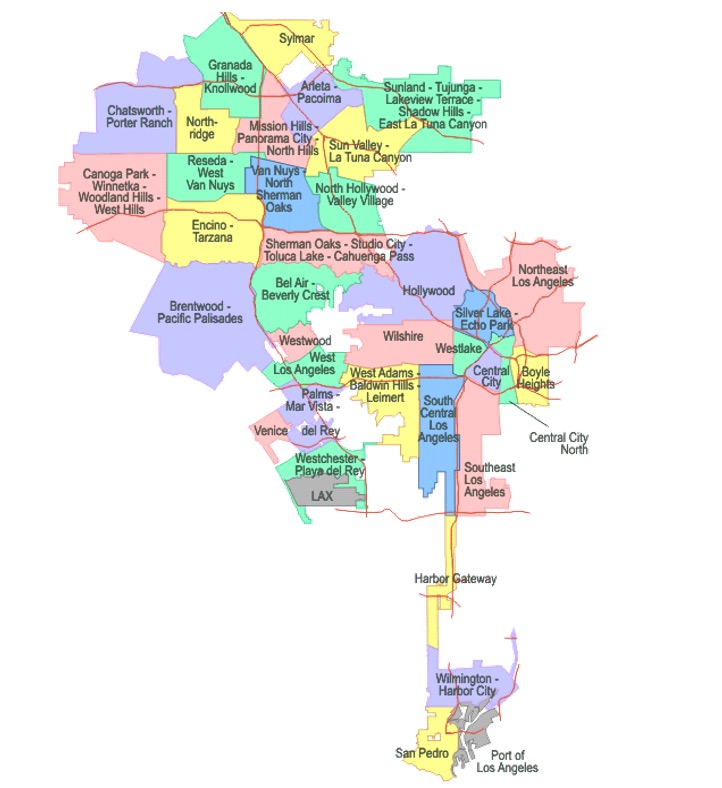Comments
PLANNING WATCH - I received a frantic call from a West Los Angeles Community Plan resident. She thought the ongoing update for her neighborhood’s Community Plan would quickly result in the immediate construction of large, expensive apartment buildings in lieu of existing homes.
This is what I explained to her. While the proposed update of her Community Plan is clearly flawed, new apartment buildings will take years to appear because they depend on unpredictable private investment decisions. There is what to worry about, but it should be based on a clear understanding of this City Hall folly, not fear stoked by local hustlers who want to buy houses before up-zoning increases their value.
This background information will help local residents, like the person who contacted me, to protect their community.
Background: Los Angeles is divided into 35 Community Plan areas, shown on the above map. The city also has two District Plans, for LAX and the port. By state law these plans must be timely and consistent with the rest of LA’s legally required General Plan. These plans are old, and all 37 of them must be updated because the City Council directed LA’s Department of City Planning to update the city’s Community and District Plans every six years.

Despite the City Council’s orders, the Community Plan updating process is painfully slow. In the past 17 years LA’s City Council has only adopted seven new Community Plans. These plans, as well as 30 others, must be updated again, but the Planning Department is only updating 17 Community Plans, for the San Fernando Valley, Southeast San Fernando Valley, Hollywood, West Los Angeles, and Downtown. None of these updates have a draft text, a Draft Environmental Impact Report, and an appended zoning ordinance. Their preparation will drag on for years, especially if the completed plans are legally challenged.
Based on current nationwide policies, including in Los Angeles, the up-zoning ordinances that implement updated Community Plans must also be prepared and adopted. These zoning ordinances are based on the conservative/neo-liberal/bi-partisan tenet that the private sector, not public agencies, should build affordable housing, but to do so require top-down economic incentives, especially density bonuses.
As I have repeatedly written, this approach does not work and ultimately backfires. This is why Angelenos see growing numbers of homeless encampments, despite affordable housing initiatives, like Mayor Bass’s ED1 housing policies. When City Hall up-zones private parcels, whether through parcel-level zone changes or community-wide up-zoning ordinances, the market value of local parcels rises. This, in turn, increases the price of housing and forces more people into homelessness. Even when these up-zoning ordinances encourage developers to build housing, the new housing is invariably expensive. This is why up-zoning does not meet the immediate shelter needs of homeless and overcrowded residents.
Myth: The counter-theory, that new, expensive market-rate housing filters down to become affordable housing, is a myth. Local advocates of up-zoning and filtering cannot identify any Los Angeles neighborhoods where up-zoning has produced affordable housing. The most obvious evidence that filtering does not work is in the Los Angeles neighborhood of Hollywood. It has record numbers of parcel-level up-zoning cases and record numbers of homeless encampments. They go hand-in-hand.
This also explains why the Department of City Planning only measures building permits granted to recently up-zoned parcels, not low-income apartments built and rented to vetted low-income residents. If they did measure these outcomes, City Hall would document that few up-zoned properties house low income tenants. This is because developers often flip up-zoned parcels instead of building new apartments, even when City Hall gives them extra height, more density, and reduced parking.
While this approach might strike you as a boondoggle, few developers complain. Their up-zoned parcels instantly become more valuable. As for new low-priced units, capitalism’s basic tenet – maximize profit – ensures that few developers choose to build money-losing affordable housing.
Bottom line: If you think that updated Community Plans solve the housing crisis through appended up-zoning ordinances, think again. Upzoning compounds the housing crisis and results in more homelessness.
As for the West Los Angeles Community Plan’s slow-moving update, the immediate danger is fear-mongers scaring existing property owners to sell cheap, not the prospects of developers replacing single-family homes with apartment buildings.
(Dick Platkin is a retired Los Angeles city planner who reports on local planning issues for CityWatchLA. He is a board member of United Neighborhoods for Los Angeles (UN4LA). Previous columns are available at the CityWatchLA archives. Please send questions to [email protected].)
















